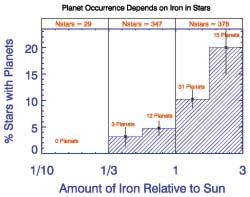This area deals with the fundamental laws and building blocks of nature and how they interact, the properties and the behavior of matter, and research into space and time and their structures.
innovations-report provides in-depth reports and articles on subjects such as astrophysics, laser technologies, nuclear, quantum, particle and solid-state physics, nanotechnologies, planetary research and findings (Mars, Venus) and developments related to the Hubble Telescope.

Scientists and engineers who work with the Far Ultraviolet Spectroscopic Explorer have pulled off a second daring and unprecedented rescue of the satellite observatory from serious guidance problems. This time, though, they didn´t actually wait for the guidance problems to happen.
In response to hints of the potential for future new difficulties with FUSE´s gyroscopes, which are used to check the satellite´s pointing accuracy, researchers redesigned software for three computers aboard FUSE a

A comparison of 754 nearby stars like our sun – some with planets and some without – shows definitively that the more iron and other metals there are in a star, the greater the chance it has a companion planet.
“Astronomers have been saying that only 5 percent of stars have planets, but that’s not a very precise assessment,” said Debra Fischer, a research astronomer at the University of California, Berkeley. “We now know that stars which are abundant in heavy metals are five times

The sun´s big, bright, explosive flares are the attention grabbers, but tiny, more numerous microflares may have nearly as much influence on the solar atmosphere, according to new data from the University of California, Berkeley´s RHESSI satellite.
Solar flares, the largest explosions in the solar system, propel energetic particles into space and are thought to be the main source of heat pumping the sun´s outer atmosphere to a few million degrees Celsius — hotter than the surface i

On 27th August, Mars will be at its closest to Earth for almost 60,000 years. On that date, the Red Planet will approach to within 34,646,418 miles (55,758,006 km) – 145 times the distance of the Moon.
The last time the two planets were so close our ancestors were living in caves and struggling to survive the extreme conditions of the Ice Age. Who knows what will have happened by the time they are as near again – 284 years into the future?
When and were to see Mars

Communicating with ESA’s spacecraft such as Mars Express, or SMART-1, Rosetta and Venus Express – yet to be launched – will be even easier and more effective when the new Cebreros ground station, near Avila (Spain), becomes operational in September 2005.
On 22 July, in Madrid, the Director General of ESA, Jean-Jacques Dordain, the Spanish Secretary of State for Defence, Mr Fernando Díez Moreno, and the Spanish Secretary of State for Science and Technology, Mr Pedro Morenés Eulate, wil

A team of UK astronomers have announced the discovery that some supernovae have bad habits – they belch out huge quantities of ’’smoke’’ known as cosmic dust. This solves a mystery more than 10 billion years in the making. The new observations published on 17th July in the journal ’’Nature’’, answer long-standing questions about the origin of the first solid particles ever to form in the Universe.
The team measured the cold cosmic dust in ’’C